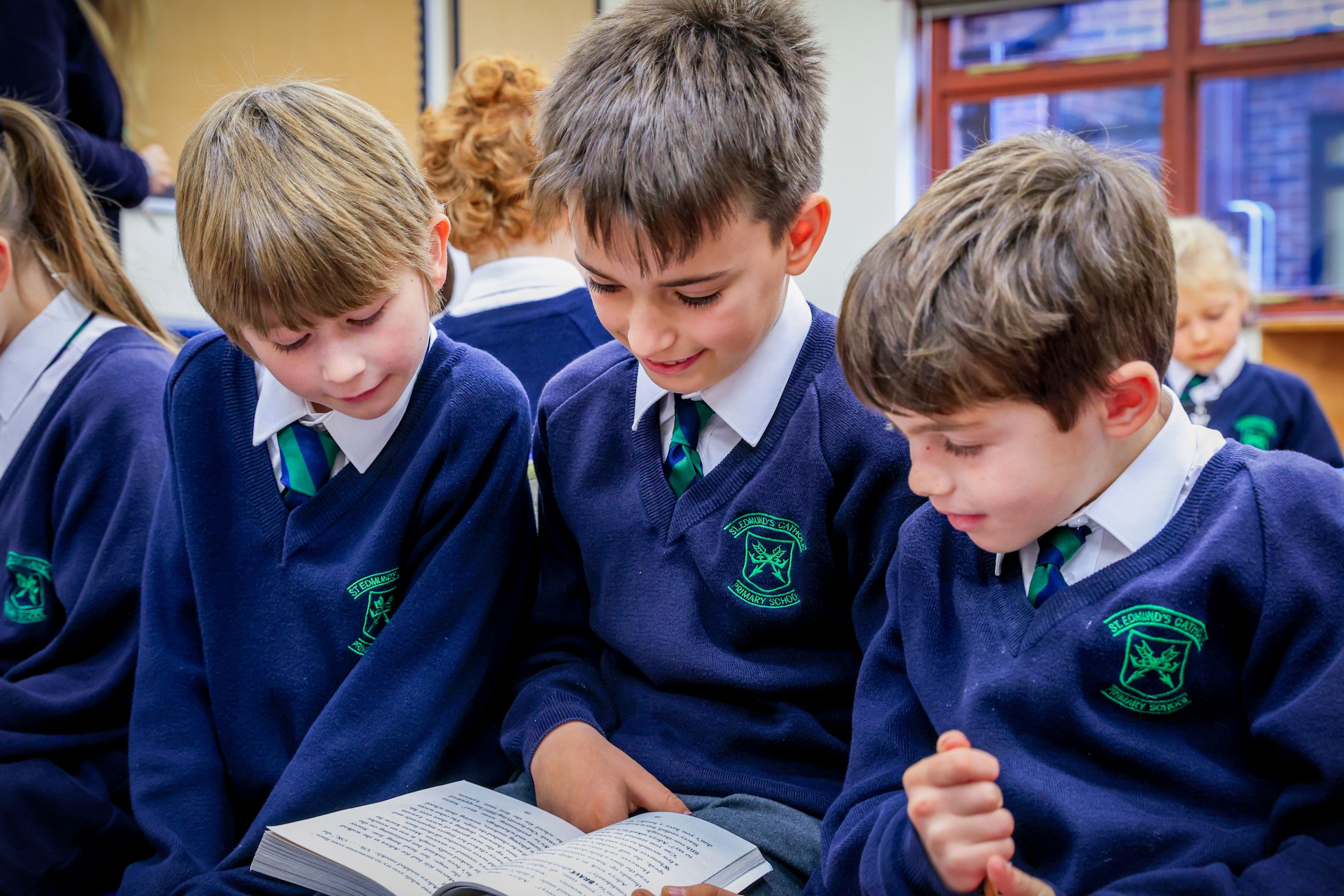English

At St Edmund’s we provide an exciting and engaging literacy curriculum. We want each pupil to develop a life-long passion for reading, a love of communicating and to be motivated, expressive writers from an early age. We have developed our curriculum with a focus on high quality literature, including fiction, non-fiction and poetry.
Reading is at the heart of St Edmund’s. We teach phonics in Reception and KS1 using the ‘Little Wandle’ scheme, and then build on this knowledge when teaching spelling, as the children progress through the school. We use Spelling Shed as a tool to teach spelling rules, patterns and formations in upper KS 1 and this then continues into KS 2 classes. Please see our Reading and Phonics page for more details.
Writing Intent
All children are provided with many opportunities to develop and apply their writing; to plan, revise and evaluate their writing, focusing on developing both transcription and composition. They will also develop an awareness of the audience, purpose and context, and an increasingly wide knowledge of vocabulary and grammar. We aim for all pupils to leave school being able to use fluent, legible and speedy handwriting.
Writing Implementation
At St Edmund's, writing begins from a very early age - as soon as a child can mark make. Gross and fine motor skills are developed through our provision within EYFS, ensuring all children developmentally prepared to form letters correctly (taught in Little Wandle Phonics).
In Key Stage 1, children are taught the skills of writing primarily through oral storytelling and discussion. This supports them to structure the text and independently write in the chosen genre. In Key Stage 2, children write in various genres for a range of purposes. They analyse the model text and unpick the grammatical features and organisation, in order to apply these in their own writing.
In KS1 and KS2, the children are encouraged to write for a range of purposes and view literacy and language as a powerful means of self-expression. Teachers use a modelled approach to support children in understanding how to shape and build a piece of writing. Work is focused around a key text and a variety of styles of writing are produced using the text as the main source of stimulus. Each class has an overview of texts for the year. Each one has been carefully selected to enrich children's learning and offer diversity and variety. Where possible, and appropriate, links have been made with varied curriculum areas in order to enhance subject knowledge. Above all, we want to create readers and writers for life, with the skills to succeed at the next stage of their education. The use of our sentence progression document helps to develop the structural and technical knowledge of language and provides a framework for progression to more discerning use of different sentence constructs.
Spelling
Our spelling curriculum follows National Curriculum guidelines developing the children’s understanding of the rules of spelling and the common exception words required in each year group. Children in the early years follow Little Wandle to become proficient in decoding words in order to spell them using their fingers to count out the number of sounds. Children in Years 2-6 receive a spelling list at the start of the spelling week which are systematically taught throughout the week. Spellings are sent home as part of homework and children are tested each week. The school also uses Spelling Shed to encourage the children to practise their spelling and to further embed the spelling rules.
Handwriting
Children in EYFS practise letter formation as part of their daily phonics. This is carried through to Year 1 where children receive timetabled handwriting sessions. In year 2, children will learn to join their handwriting. We use a handwriting scheme called Letter-join. Letter-join is an on-line resource for teaching cursive handwriting on PCs and tablets. It uses interactive animations to demonstrate joined-up letter formation and has practice screens to trace over on your tablet. There are lots of additional resources to print out and a Worksheet Generator for real handwriting practice. Letter-join’s phonics resources are designed to complement our Little Wandle phonics programme, providing an extension to your pupils’ phonics learning and helping them to meet National Curriculum requirements. It offers a wide range of engaging games, activities and worksheets linking the phonemes and graphemes in phases 2 to 5 with handwriting practice.
In Key Stage 2, children continue to work on joining, legibility and writing at length. We encourage children to write fluently in a neat, cursive style throughout the curriculum. Opportunities are given to showcase best handwriting when children ‘publish’ their work and present it for display.
Impact
The impact of our English Curriculum can be seen in the pupils’ ability to speak, discuss, read and write confidently and effectively. The organisation of the English curriculum has realised a community of enthusiastic readers and writers who enjoy showcasing their developing literacy knowledge and skills. Children are confident to take risks in their reading and writing, and love to discuss and share their ideas. Outcomes of work in both literacy and RE/topic books evidence the high quality of work and the impact of varied and cross-curricular writing opportunities. These enable children to write across a range of forms and adapt their writing successfully, considering the purpose.
Attainment at the end of EYFS, KS1 and KS2 is above that of Surrey and the National Average. Children also achieve highly in the phonics screening check.

